The Effect of Motivation Techniques on Employee Productivity: A Report
VerifiedAdded on 2020/02/19
|10
|2171
|60
Report
AI Summary
This report provides an analysis of an article concerning the effect of motivational techniques used by managers to increase worker productivity. It begins with an introduction and a clear thesis statement, asserting the effectiveness of motivational techniques in boosting organizational production levels. The report highlights the strengths of the original article, such as its well-structured research methodology involving a survey of employees and managers from different sectors. It also acknowledges the weaknesses, including the potential limitations of applying the same techniques across diverse cultural and psychological backgrounds. The reflective analysis strongly agrees with the thesis, emphasizing the importance of motivation in aligning employees with organizational goals. Key points supporting this viewpoint include the vital role of employees in organizational development, the impact of competition, and the need for a healthy work environment. The report supports its arguments with examples like Google's motivational strategies and references to Herzberg's two-factor theory, which distinguishes between satisfiers and dissatisfiers. Additionally, it discusses the importance of transparency, commitment, teamwork, and skill development through motivational techniques. The conclusion reiterates the benefits of motivational strategies, despite their variability, in enhancing organizational behavior and development.
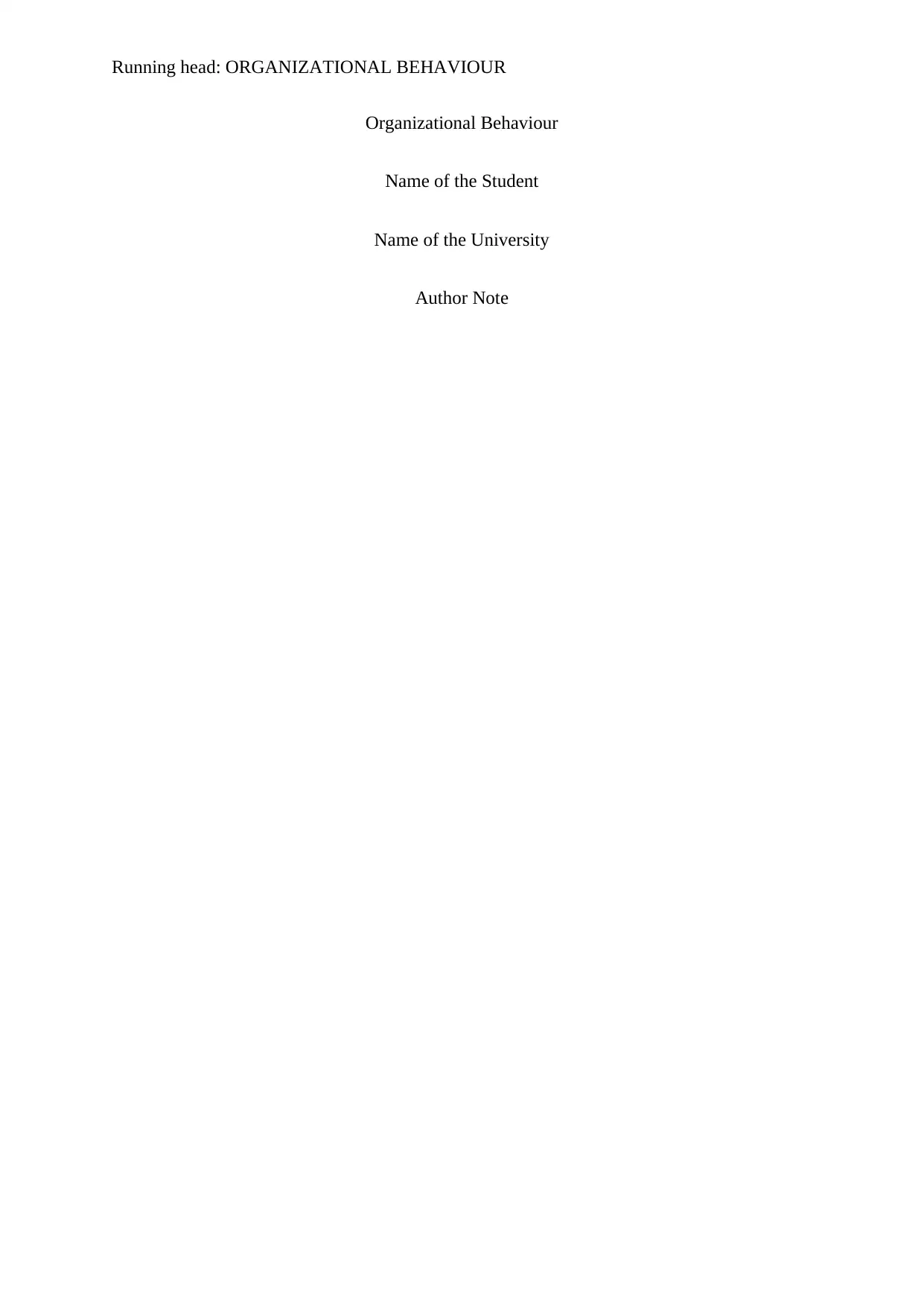
Running head: ORGANIZATIONAL BEHAVIOUR
Organizational Behaviour
Name of the Student
Name of the University
Author Note
Organizational Behaviour
Name of the Student
Name of the University
Author Note
Paraphrase This Document
Need a fresh take? Get an instant paraphrase of this document with our AI Paraphraser
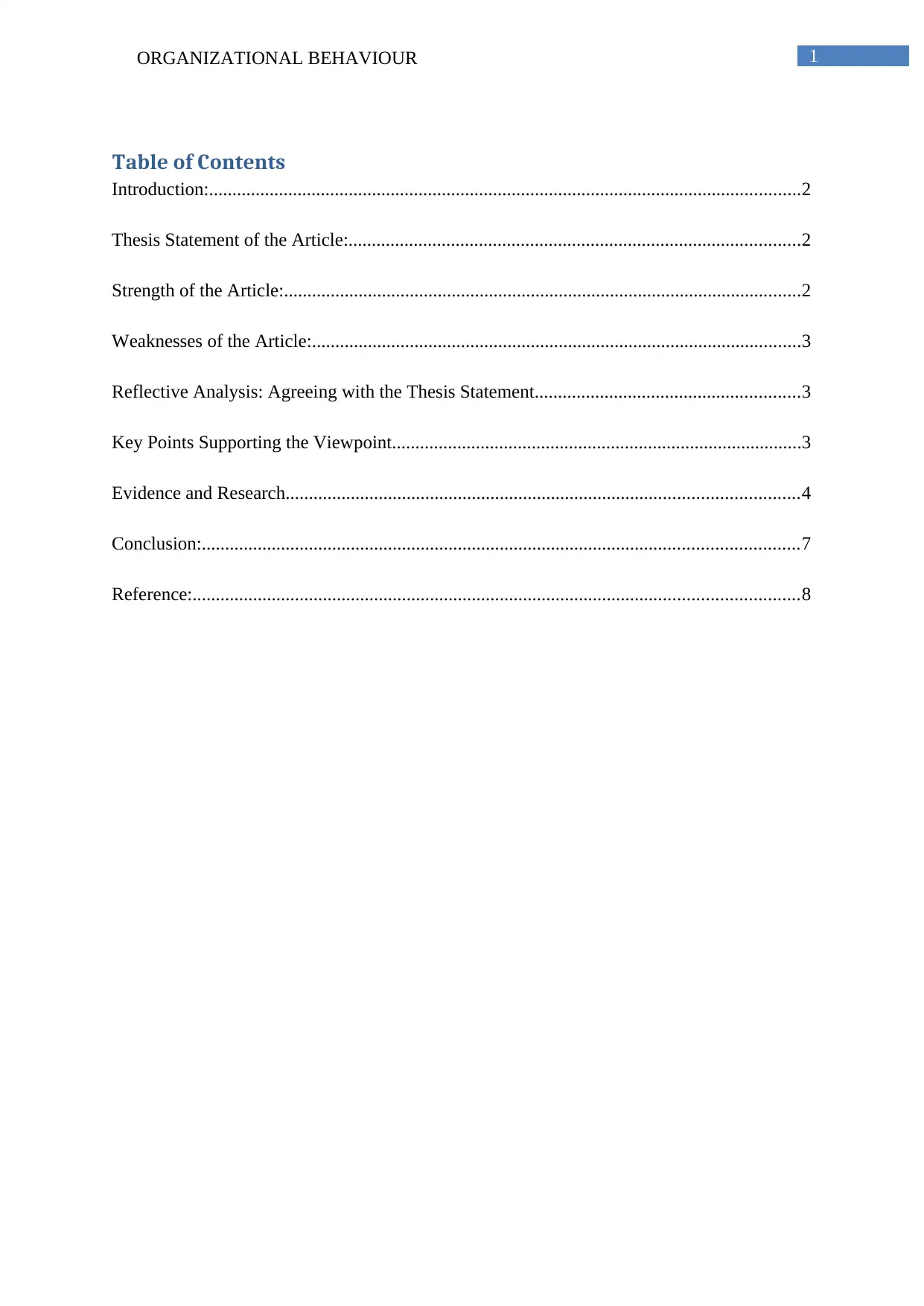
1ORGANIZATIONAL BEHAVIOUR
Table of Contents
Introduction:...............................................................................................................................2
Thesis Statement of the Article:.................................................................................................2
Strength of the Article:...............................................................................................................2
Weaknesses of the Article:.........................................................................................................3
Reflective Analysis: Agreeing with the Thesis Statement.........................................................3
Key Points Supporting the Viewpoint........................................................................................3
Evidence and Research..............................................................................................................4
Conclusion:................................................................................................................................7
Reference:..................................................................................................................................8
Table of Contents
Introduction:...............................................................................................................................2
Thesis Statement of the Article:.................................................................................................2
Strength of the Article:...............................................................................................................2
Weaknesses of the Article:.........................................................................................................3
Reflective Analysis: Agreeing with the Thesis Statement.........................................................3
Key Points Supporting the Viewpoint........................................................................................3
Evidence and Research..............................................................................................................4
Conclusion:................................................................................................................................7
Reference:..................................................................................................................................8
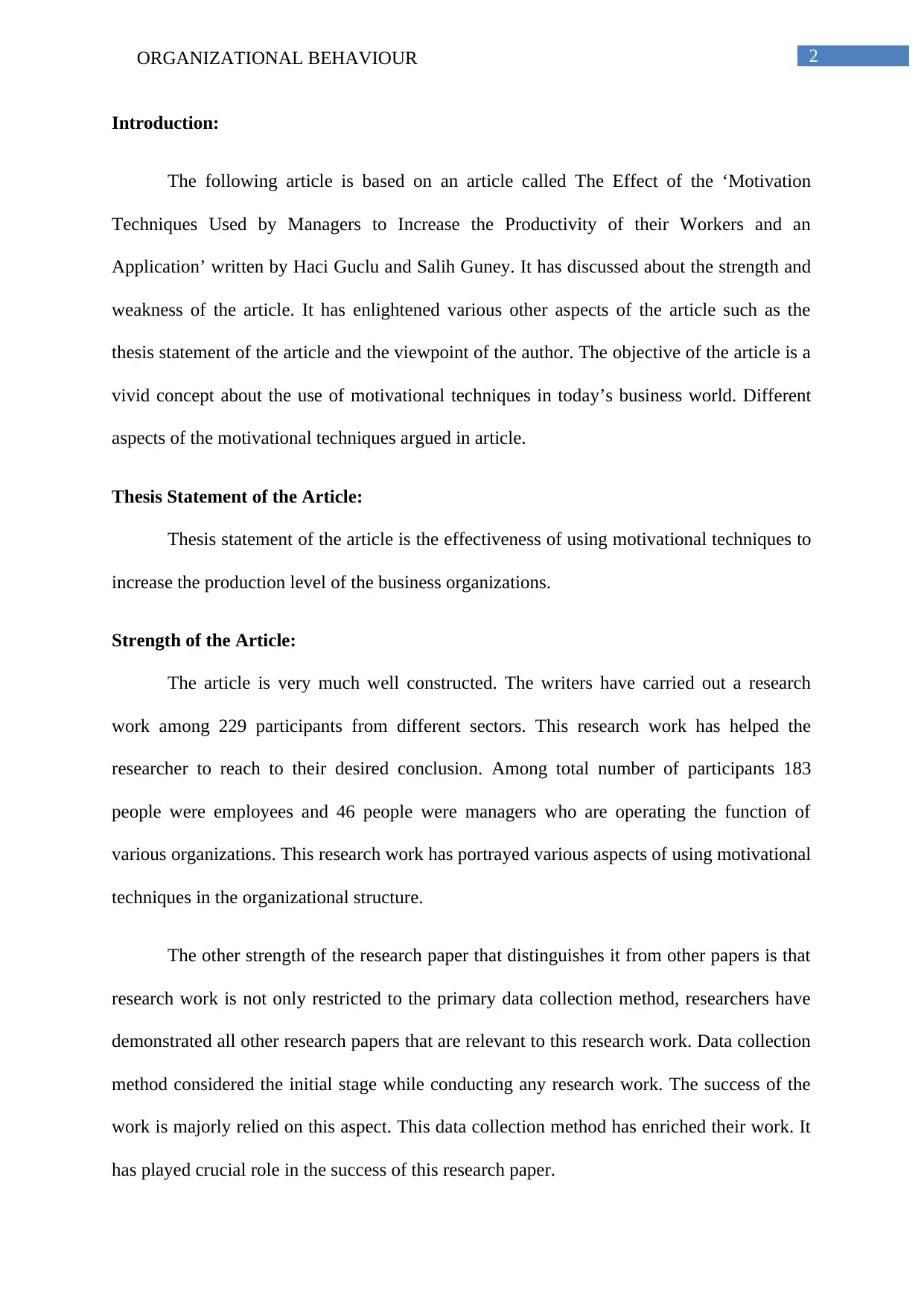
2ORGANIZATIONAL BEHAVIOUR
Introduction:
The following article is based on an article called The Effect of the ‘Motivation
Techniques Used by Managers to Increase the Productivity of their Workers and an
Application’ written by Haci Guclu and Salih Guney. It has discussed about the strength and
weakness of the article. It has enlightened various other aspects of the article such as the
thesis statement of the article and the viewpoint of the author. The objective of the article is a
vivid concept about the use of motivational techniques in today’s business world. Different
aspects of the motivational techniques argued in article.
Thesis Statement of the Article:
Thesis statement of the article is the effectiveness of using motivational techniques to
increase the production level of the business organizations.
Strength of the Article:
The article is very much well constructed. The writers have carried out a research
work among 229 participants from different sectors. This research work has helped the
researcher to reach to their desired conclusion. Among total number of participants 183
people were employees and 46 people were managers who are operating the function of
various organizations. This research work has portrayed various aspects of using motivational
techniques in the organizational structure.
The other strength of the research paper that distinguishes it from other papers is that
research work is not only restricted to the primary data collection method, researchers have
demonstrated all other research papers that are relevant to this research work. Data collection
method considered the initial stage while conducting any research work. The success of the
work is majorly relied on this aspect. This data collection method has enriched their work. It
has played crucial role in the success of this research paper.
Introduction:
The following article is based on an article called The Effect of the ‘Motivation
Techniques Used by Managers to Increase the Productivity of their Workers and an
Application’ written by Haci Guclu and Salih Guney. It has discussed about the strength and
weakness of the article. It has enlightened various other aspects of the article such as the
thesis statement of the article and the viewpoint of the author. The objective of the article is a
vivid concept about the use of motivational techniques in today’s business world. Different
aspects of the motivational techniques argued in article.
Thesis Statement of the Article:
Thesis statement of the article is the effectiveness of using motivational techniques to
increase the production level of the business organizations.
Strength of the Article:
The article is very much well constructed. The writers have carried out a research
work among 229 participants from different sectors. This research work has helped the
researcher to reach to their desired conclusion. Among total number of participants 183
people were employees and 46 people were managers who are operating the function of
various organizations. This research work has portrayed various aspects of using motivational
techniques in the organizational structure.
The other strength of the research paper that distinguishes it from other papers is that
research work is not only restricted to the primary data collection method, researchers have
demonstrated all other research papers that are relevant to this research work. Data collection
method considered the initial stage while conducting any research work. The success of the
work is majorly relied on this aspect. This data collection method has enriched their work. It
has played crucial role in the success of this research paper.
⊘ This is a preview!⊘
Do you want full access?
Subscribe today to unlock all pages.

Trusted by 1+ million students worldwide
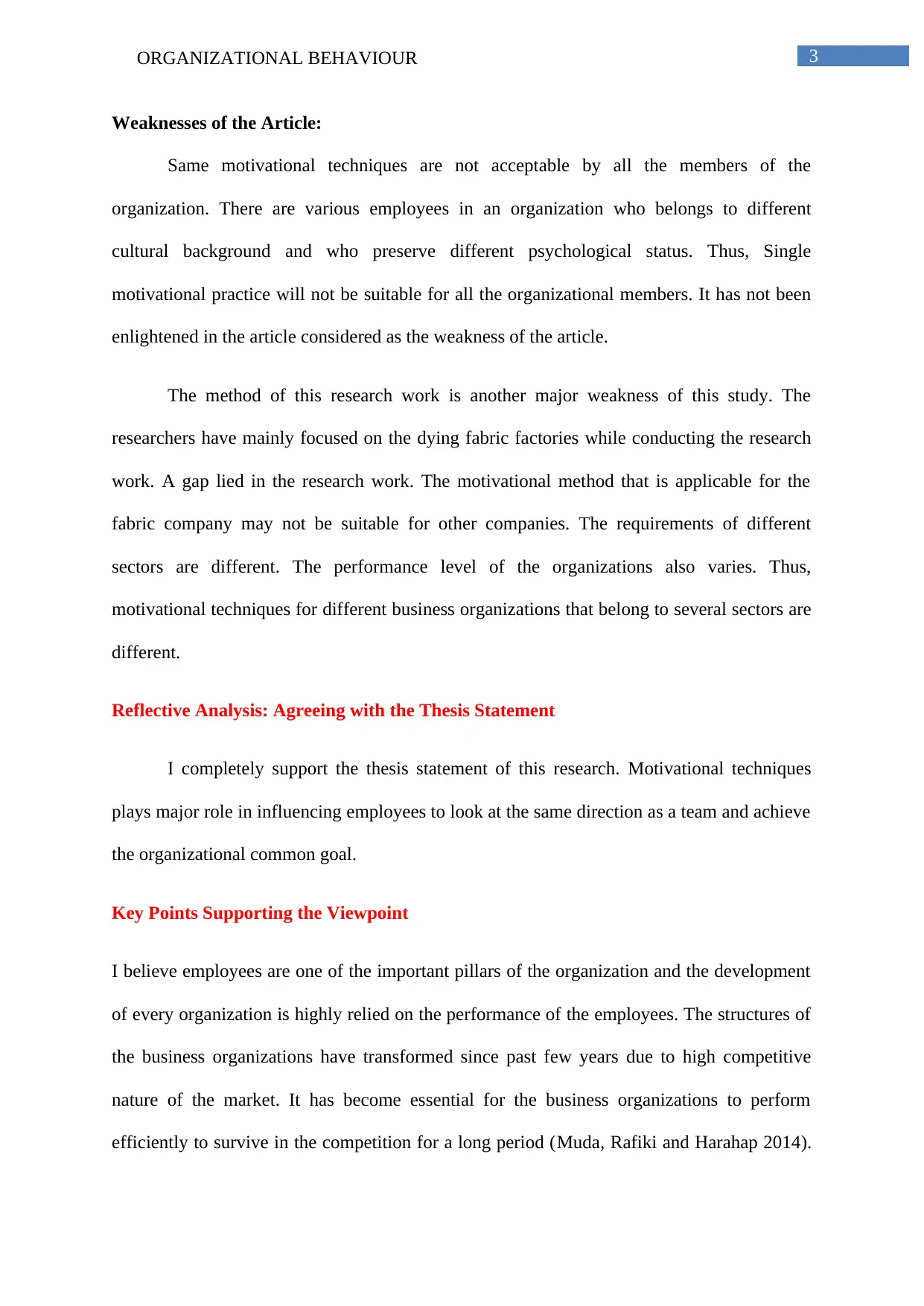
3ORGANIZATIONAL BEHAVIOUR
Weaknesses of the Article:
Same motivational techniques are not acceptable by all the members of the
organization. There are various employees in an organization who belongs to different
cultural background and who preserve different psychological status. Thus, Single
motivational practice will not be suitable for all the organizational members. It has not been
enlightened in the article considered as the weakness of the article.
The method of this research work is another major weakness of this study. The
researchers have mainly focused on the dying fabric factories while conducting the research
work. A gap lied in the research work. The motivational method that is applicable for the
fabric company may not be suitable for other companies. The requirements of different
sectors are different. The performance level of the organizations also varies. Thus,
motivational techniques for different business organizations that belong to several sectors are
different.
Reflective Analysis: Agreeing with the Thesis Statement
I completely support the thesis statement of this research. Motivational techniques
plays major role in influencing employees to look at the same direction as a team and achieve
the organizational common goal.
Key Points Supporting the Viewpoint
I believe employees are one of the important pillars of the organization and the development
of every organization is highly relied on the performance of the employees. The structures of
the business organizations have transformed since past few years due to high competitive
nature of the market. It has become essential for the business organizations to perform
efficiently to survive in the competition for a long period (Muda, Rafiki and Harahap 2014).
Weaknesses of the Article:
Same motivational techniques are not acceptable by all the members of the
organization. There are various employees in an organization who belongs to different
cultural background and who preserve different psychological status. Thus, Single
motivational practice will not be suitable for all the organizational members. It has not been
enlightened in the article considered as the weakness of the article.
The method of this research work is another major weakness of this study. The
researchers have mainly focused on the dying fabric factories while conducting the research
work. A gap lied in the research work. The motivational method that is applicable for the
fabric company may not be suitable for other companies. The requirements of different
sectors are different. The performance level of the organizations also varies. Thus,
motivational techniques for different business organizations that belong to several sectors are
different.
Reflective Analysis: Agreeing with the Thesis Statement
I completely support the thesis statement of this research. Motivational techniques
plays major role in influencing employees to look at the same direction as a team and achieve
the organizational common goal.
Key Points Supporting the Viewpoint
I believe employees are one of the important pillars of the organization and the development
of every organization is highly relied on the performance of the employees. The structures of
the business organizations have transformed since past few years due to high competitive
nature of the market. It has become essential for the business organizations to perform
efficiently to survive in the competition for a long period (Muda, Rafiki and Harahap 2014).
Paraphrase This Document
Need a fresh take? Get an instant paraphrase of this document with our AI Paraphraser
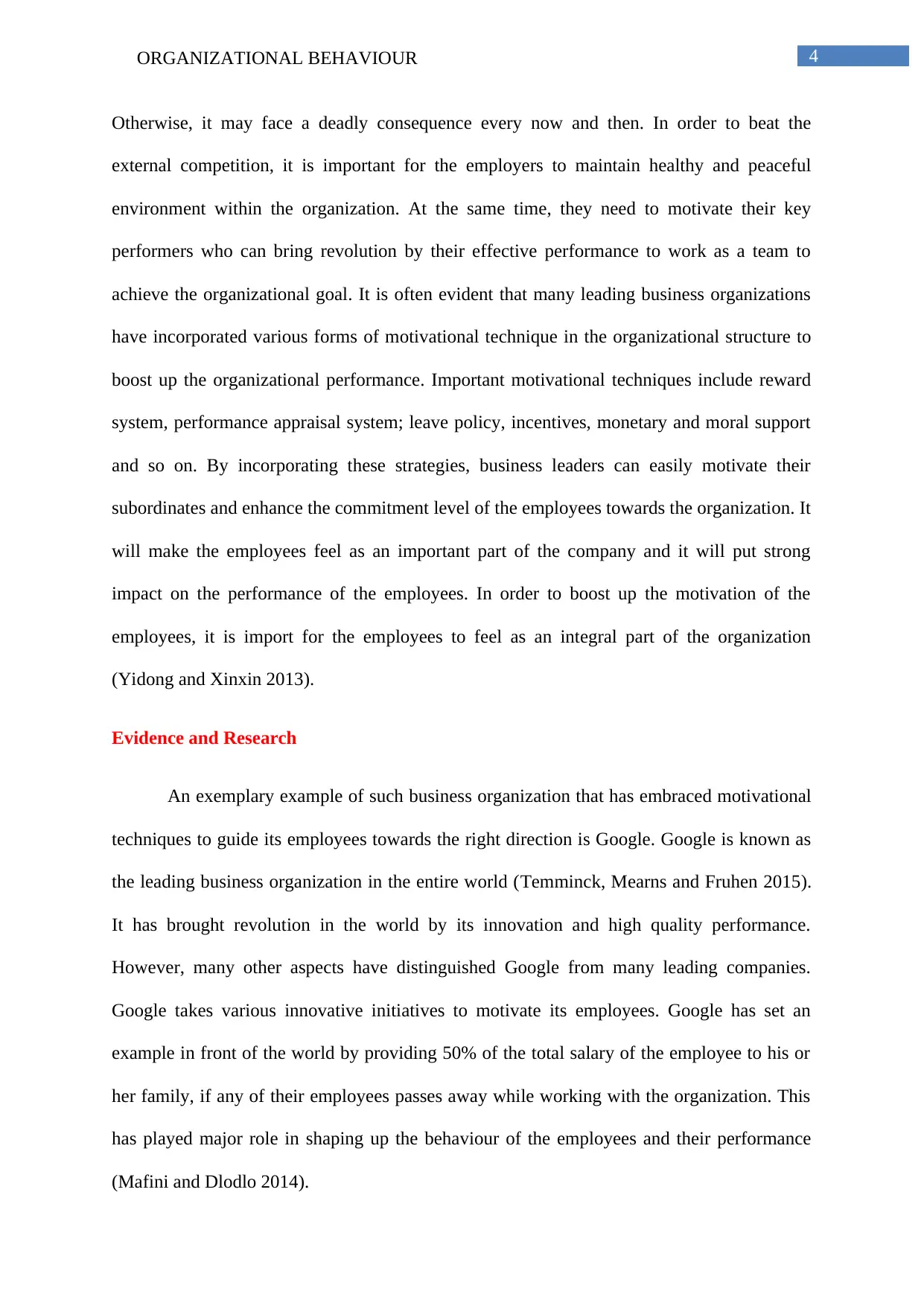
4ORGANIZATIONAL BEHAVIOUR
Otherwise, it may face a deadly consequence every now and then. In order to beat the
external competition, it is important for the employers to maintain healthy and peaceful
environment within the organization. At the same time, they need to motivate their key
performers who can bring revolution by their effective performance to work as a team to
achieve the organizational goal. It is often evident that many leading business organizations
have incorporated various forms of motivational technique in the organizational structure to
boost up the organizational performance. Important motivational techniques include reward
system, performance appraisal system; leave policy, incentives, monetary and moral support
and so on. By incorporating these strategies, business leaders can easily motivate their
subordinates and enhance the commitment level of the employees towards the organization. It
will make the employees feel as an important part of the company and it will put strong
impact on the performance of the employees. In order to boost up the motivation of the
employees, it is import for the employees to feel as an integral part of the organization
(Yidong and Xinxin 2013).
Evidence and Research
An exemplary example of such business organization that has embraced motivational
techniques to guide its employees towards the right direction is Google. Google is known as
the leading business organization in the entire world (Temminck, Mearns and Fruhen 2015).
It has brought revolution in the world by its innovation and high quality performance.
However, many other aspects have distinguished Google from many leading companies.
Google takes various innovative initiatives to motivate its employees. Google has set an
example in front of the world by providing 50% of the total salary of the employee to his or
her family, if any of their employees passes away while working with the organization. This
has played major role in shaping up the behaviour of the employees and their performance
(Mafini and Dlodlo 2014).
Otherwise, it may face a deadly consequence every now and then. In order to beat the
external competition, it is important for the employers to maintain healthy and peaceful
environment within the organization. At the same time, they need to motivate their key
performers who can bring revolution by their effective performance to work as a team to
achieve the organizational goal. It is often evident that many leading business organizations
have incorporated various forms of motivational technique in the organizational structure to
boost up the organizational performance. Important motivational techniques include reward
system, performance appraisal system; leave policy, incentives, monetary and moral support
and so on. By incorporating these strategies, business leaders can easily motivate their
subordinates and enhance the commitment level of the employees towards the organization. It
will make the employees feel as an important part of the company and it will put strong
impact on the performance of the employees. In order to boost up the motivation of the
employees, it is import for the employees to feel as an integral part of the organization
(Yidong and Xinxin 2013).
Evidence and Research
An exemplary example of such business organization that has embraced motivational
techniques to guide its employees towards the right direction is Google. Google is known as
the leading business organization in the entire world (Temminck, Mearns and Fruhen 2015).
It has brought revolution in the world by its innovation and high quality performance.
However, many other aspects have distinguished Google from many leading companies.
Google takes various innovative initiatives to motivate its employees. Google has set an
example in front of the world by providing 50% of the total salary of the employee to his or
her family, if any of their employees passes away while working with the organization. This
has played major role in shaping up the behaviour of the employees and their performance
(Mafini and Dlodlo 2014).
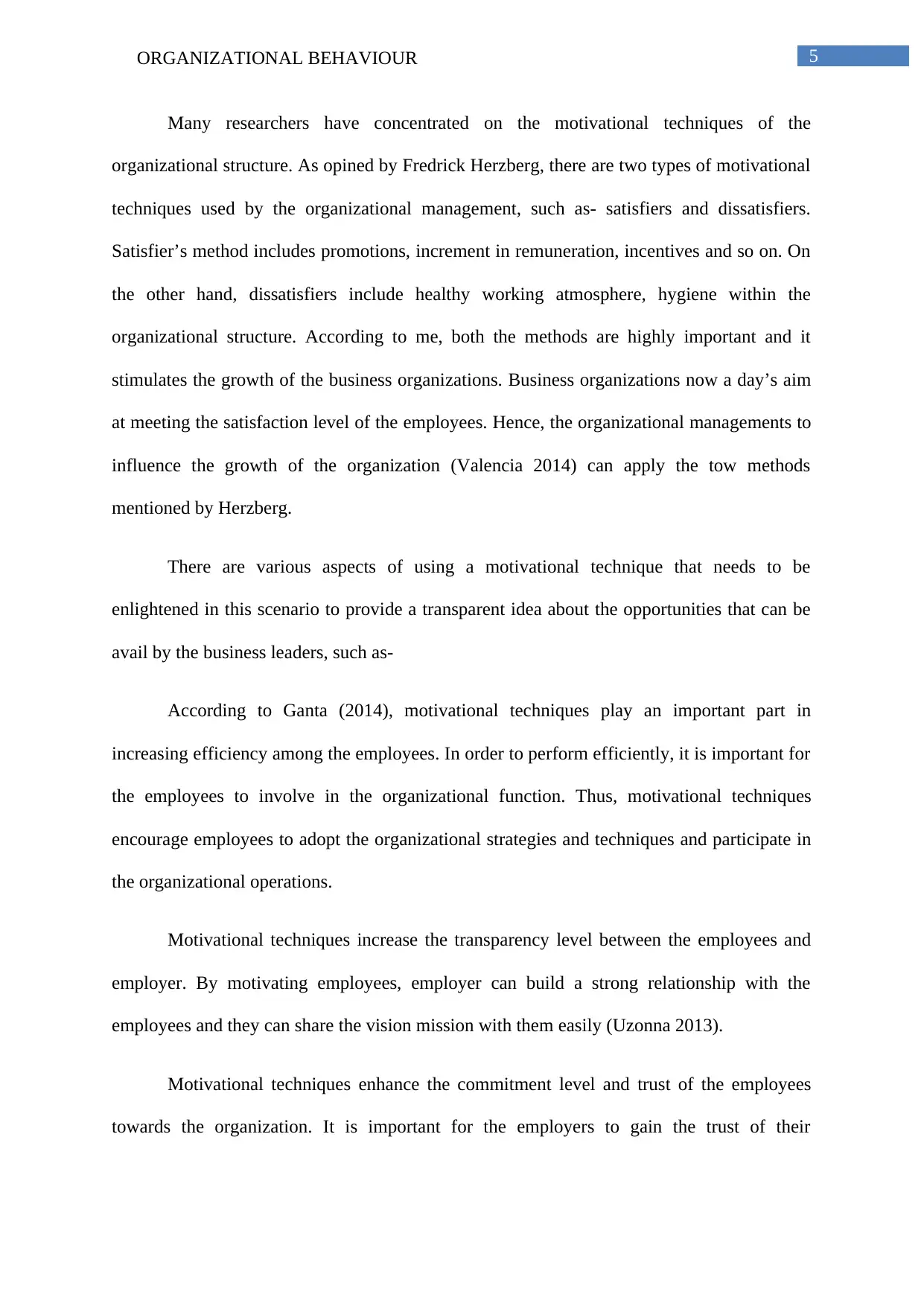
5ORGANIZATIONAL BEHAVIOUR
Many researchers have concentrated on the motivational techniques of the
organizational structure. As opined by Fredrick Herzberg, there are two types of motivational
techniques used by the organizational management, such as- satisfiers and dissatisfiers.
Satisfier’s method includes promotions, increment in remuneration, incentives and so on. On
the other hand, dissatisfiers include healthy working atmosphere, hygiene within the
organizational structure. According to me, both the methods are highly important and it
stimulates the growth of the business organizations. Business organizations now a day’s aim
at meeting the satisfaction level of the employees. Hence, the organizational managements to
influence the growth of the organization (Valencia 2014) can apply the tow methods
mentioned by Herzberg.
There are various aspects of using a motivational technique that needs to be
enlightened in this scenario to provide a transparent idea about the opportunities that can be
avail by the business leaders, such as-
According to Ganta (2014), motivational techniques play an important part in
increasing efficiency among the employees. In order to perform efficiently, it is important for
the employees to involve in the organizational function. Thus, motivational techniques
encourage employees to adopt the organizational strategies and techniques and participate in
the organizational operations.
Motivational techniques increase the transparency level between the employees and
employer. By motivating employees, employer can build a strong relationship with the
employees and they can share the vision mission with them easily (Uzonna 2013).
Motivational techniques enhance the commitment level and trust of the employees
towards the organization. It is important for the employers to gain the trust of their
Many researchers have concentrated on the motivational techniques of the
organizational structure. As opined by Fredrick Herzberg, there are two types of motivational
techniques used by the organizational management, such as- satisfiers and dissatisfiers.
Satisfier’s method includes promotions, increment in remuneration, incentives and so on. On
the other hand, dissatisfiers include healthy working atmosphere, hygiene within the
organizational structure. According to me, both the methods are highly important and it
stimulates the growth of the business organizations. Business organizations now a day’s aim
at meeting the satisfaction level of the employees. Hence, the organizational managements to
influence the growth of the organization (Valencia 2014) can apply the tow methods
mentioned by Herzberg.
There are various aspects of using a motivational technique that needs to be
enlightened in this scenario to provide a transparent idea about the opportunities that can be
avail by the business leaders, such as-
According to Ganta (2014), motivational techniques play an important part in
increasing efficiency among the employees. In order to perform efficiently, it is important for
the employees to involve in the organizational function. Thus, motivational techniques
encourage employees to adopt the organizational strategies and techniques and participate in
the organizational operations.
Motivational techniques increase the transparency level between the employees and
employer. By motivating employees, employer can build a strong relationship with the
employees and they can share the vision mission with them easily (Uzonna 2013).
Motivational techniques enhance the commitment level and trust of the employees
towards the organization. It is important for the employers to gain the trust of their
⊘ This is a preview!⊘
Do you want full access?
Subscribe today to unlock all pages.

Trusted by 1+ million students worldwide
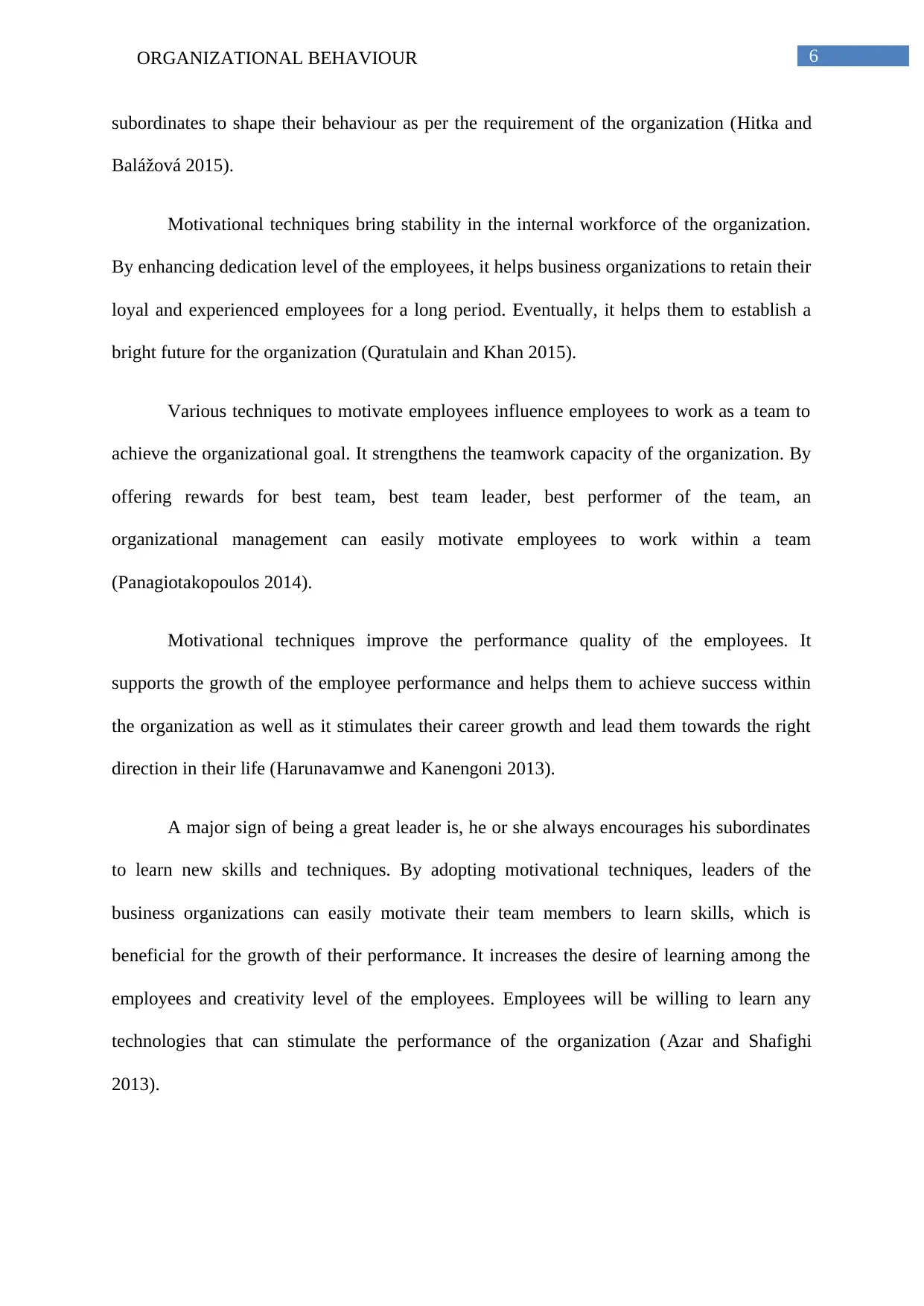
6ORGANIZATIONAL BEHAVIOUR
subordinates to shape their behaviour as per the requirement of the organization (Hitka and
Balážová 2015).
Motivational techniques bring stability in the internal workforce of the organization.
By enhancing dedication level of the employees, it helps business organizations to retain their
loyal and experienced employees for a long period. Eventually, it helps them to establish a
bright future for the organization (Quratulain and Khan 2015).
Various techniques to motivate employees influence employees to work as a team to
achieve the organizational goal. It strengthens the teamwork capacity of the organization. By
offering rewards for best team, best team leader, best performer of the team, an
organizational management can easily motivate employees to work within a team
(Panagiotakopoulos 2014).
Motivational techniques improve the performance quality of the employees. It
supports the growth of the employee performance and helps them to achieve success within
the organization as well as it stimulates their career growth and lead them towards the right
direction in their life (Harunavamwe and Kanengoni 2013).
A major sign of being a great leader is, he or she always encourages his subordinates
to learn new skills and techniques. By adopting motivational techniques, leaders of the
business organizations can easily motivate their team members to learn skills, which is
beneficial for the growth of their performance. It increases the desire of learning among the
employees and creativity level of the employees. Employees will be willing to learn any
technologies that can stimulate the performance of the organization (Azar and Shafighi
2013).
subordinates to shape their behaviour as per the requirement of the organization (Hitka and
Balážová 2015).
Motivational techniques bring stability in the internal workforce of the organization.
By enhancing dedication level of the employees, it helps business organizations to retain their
loyal and experienced employees for a long period. Eventually, it helps them to establish a
bright future for the organization (Quratulain and Khan 2015).
Various techniques to motivate employees influence employees to work as a team to
achieve the organizational goal. It strengthens the teamwork capacity of the organization. By
offering rewards for best team, best team leader, best performer of the team, an
organizational management can easily motivate employees to work within a team
(Panagiotakopoulos 2014).
Motivational techniques improve the performance quality of the employees. It
supports the growth of the employee performance and helps them to achieve success within
the organization as well as it stimulates their career growth and lead them towards the right
direction in their life (Harunavamwe and Kanengoni 2013).
A major sign of being a great leader is, he or she always encourages his subordinates
to learn new skills and techniques. By adopting motivational techniques, leaders of the
business organizations can easily motivate their team members to learn skills, which is
beneficial for the growth of their performance. It increases the desire of learning among the
employees and creativity level of the employees. Employees will be willing to learn any
technologies that can stimulate the performance of the organization (Azar and Shafighi
2013).
Paraphrase This Document
Need a fresh take? Get an instant paraphrase of this document with our AI Paraphraser
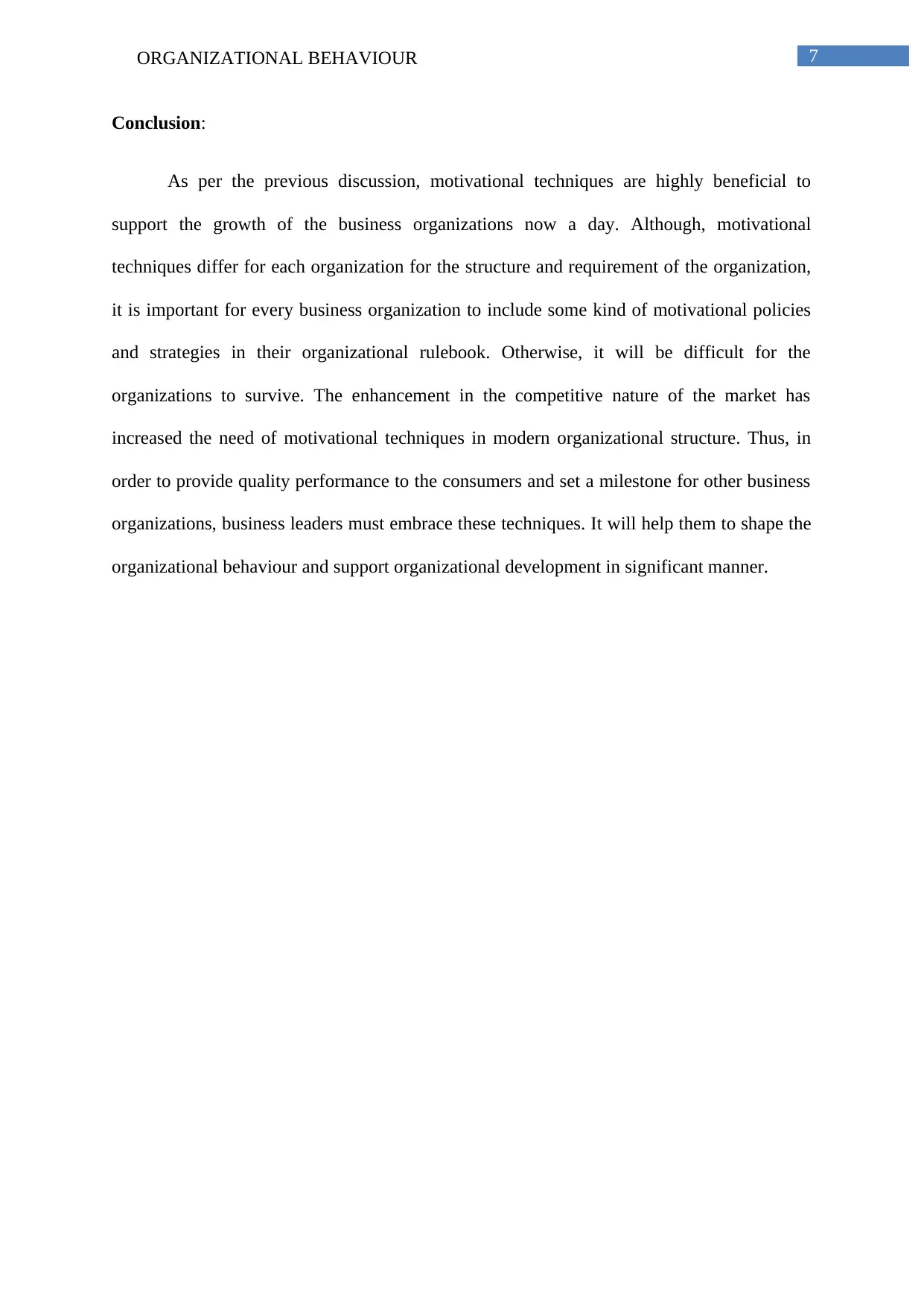
7ORGANIZATIONAL BEHAVIOUR
Conclusion:
As per the previous discussion, motivational techniques are highly beneficial to
support the growth of the business organizations now a day. Although, motivational
techniques differ for each organization for the structure and requirement of the organization,
it is important for every business organization to include some kind of motivational policies
and strategies in their organizational rulebook. Otherwise, it will be difficult for the
organizations to survive. The enhancement in the competitive nature of the market has
increased the need of motivational techniques in modern organizational structure. Thus, in
order to provide quality performance to the consumers and set a milestone for other business
organizations, business leaders must embrace these techniques. It will help them to shape the
organizational behaviour and support organizational development in significant manner.
Conclusion:
As per the previous discussion, motivational techniques are highly beneficial to
support the growth of the business organizations now a day. Although, motivational
techniques differ for each organization for the structure and requirement of the organization,
it is important for every business organization to include some kind of motivational policies
and strategies in their organizational rulebook. Otherwise, it will be difficult for the
organizations to survive. The enhancement in the competitive nature of the market has
increased the need of motivational techniques in modern organizational structure. Thus, in
order to provide quality performance to the consumers and set a milestone for other business
organizations, business leaders must embrace these techniques. It will help them to shape the
organizational behaviour and support organizational development in significant manner.
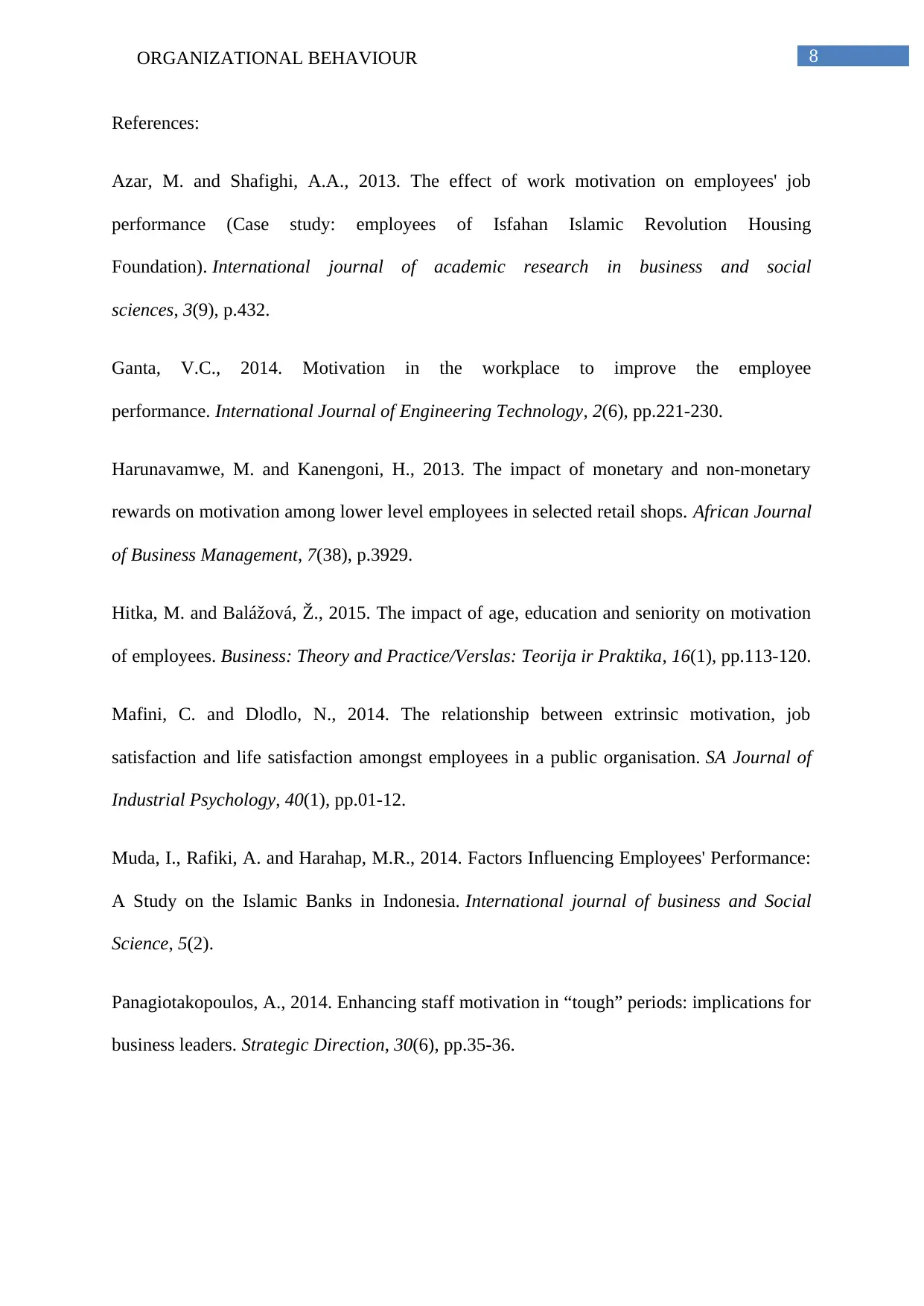
8ORGANIZATIONAL BEHAVIOUR
References:
Azar, M. and Shafighi, A.A., 2013. The effect of work motivation on employees' job
performance (Case study: employees of Isfahan Islamic Revolution Housing
Foundation). International journal of academic research in business and social
sciences, 3(9), p.432.
Ganta, V.C., 2014. Motivation in the workplace to improve the employee
performance. International Journal of Engineering Technology, 2(6), pp.221-230.
Harunavamwe, M. and Kanengoni, H., 2013. The impact of monetary and non-monetary
rewards on motivation among lower level employees in selected retail shops. African Journal
of Business Management, 7(38), p.3929.
Hitka, M. and Balážová, Ž., 2015. The impact of age, education and seniority on motivation
of employees. Business: Theory and Practice/Verslas: Teorija ir Praktika, 16(1), pp.113-120.
Mafini, C. and Dlodlo, N., 2014. The relationship between extrinsic motivation, job
satisfaction and life satisfaction amongst employees in a public organisation. SA Journal of
Industrial Psychology, 40(1), pp.01-12.
Muda, I., Rafiki, A. and Harahap, M.R., 2014. Factors Influencing Employees' Performance:
A Study on the Islamic Banks in Indonesia. International journal of business and Social
Science, 5(2).
Panagiotakopoulos, A., 2014. Enhancing staff motivation in “tough” periods: implications for
business leaders. Strategic Direction, 30(6), pp.35-36.
References:
Azar, M. and Shafighi, A.A., 2013. The effect of work motivation on employees' job
performance (Case study: employees of Isfahan Islamic Revolution Housing
Foundation). International journal of academic research in business and social
sciences, 3(9), p.432.
Ganta, V.C., 2014. Motivation in the workplace to improve the employee
performance. International Journal of Engineering Technology, 2(6), pp.221-230.
Harunavamwe, M. and Kanengoni, H., 2013. The impact of monetary and non-monetary
rewards on motivation among lower level employees in selected retail shops. African Journal
of Business Management, 7(38), p.3929.
Hitka, M. and Balážová, Ž., 2015. The impact of age, education and seniority on motivation
of employees. Business: Theory and Practice/Verslas: Teorija ir Praktika, 16(1), pp.113-120.
Mafini, C. and Dlodlo, N., 2014. The relationship between extrinsic motivation, job
satisfaction and life satisfaction amongst employees in a public organisation. SA Journal of
Industrial Psychology, 40(1), pp.01-12.
Muda, I., Rafiki, A. and Harahap, M.R., 2014. Factors Influencing Employees' Performance:
A Study on the Islamic Banks in Indonesia. International journal of business and Social
Science, 5(2).
Panagiotakopoulos, A., 2014. Enhancing staff motivation in “tough” periods: implications for
business leaders. Strategic Direction, 30(6), pp.35-36.
⊘ This is a preview!⊘
Do you want full access?
Subscribe today to unlock all pages.

Trusted by 1+ million students worldwide
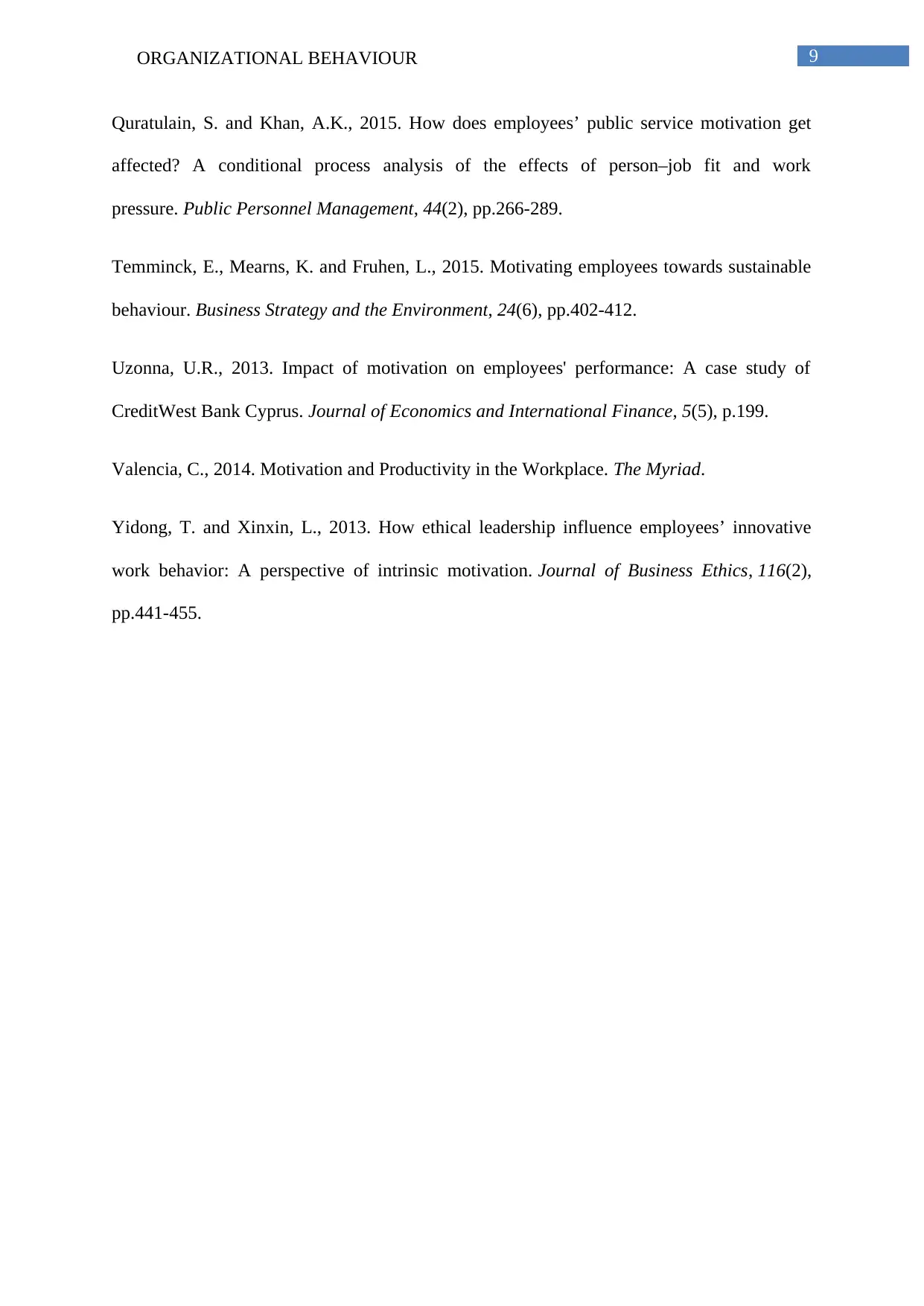
9ORGANIZATIONAL BEHAVIOUR
Quratulain, S. and Khan, A.K., 2015. How does employees’ public service motivation get
affected? A conditional process analysis of the effects of person–job fit and work
pressure. Public Personnel Management, 44(2), pp.266-289.
Temminck, E., Mearns, K. and Fruhen, L., 2015. Motivating employees towards sustainable
behaviour. Business Strategy and the Environment, 24(6), pp.402-412.
Uzonna, U.R., 2013. Impact of motivation on employees' performance: A case study of
CreditWest Bank Cyprus. Journal of Economics and International Finance, 5(5), p.199.
Valencia, C., 2014. Motivation and Productivity in the Workplace. The Myriad.
Yidong, T. and Xinxin, L., 2013. How ethical leadership influence employees’ innovative
work behavior: A perspective of intrinsic motivation. Journal of Business Ethics, 116(2),
pp.441-455.
Quratulain, S. and Khan, A.K., 2015. How does employees’ public service motivation get
affected? A conditional process analysis of the effects of person–job fit and work
pressure. Public Personnel Management, 44(2), pp.266-289.
Temminck, E., Mearns, K. and Fruhen, L., 2015. Motivating employees towards sustainable
behaviour. Business Strategy and the Environment, 24(6), pp.402-412.
Uzonna, U.R., 2013. Impact of motivation on employees' performance: A case study of
CreditWest Bank Cyprus. Journal of Economics and International Finance, 5(5), p.199.
Valencia, C., 2014. Motivation and Productivity in the Workplace. The Myriad.
Yidong, T. and Xinxin, L., 2013. How ethical leadership influence employees’ innovative
work behavior: A perspective of intrinsic motivation. Journal of Business Ethics, 116(2),
pp.441-455.
1 out of 10
Related Documents
Your All-in-One AI-Powered Toolkit for Academic Success.
+13062052269
info@desklib.com
Available 24*7 on WhatsApp / Email
![[object Object]](/_next/static/media/star-bottom.7253800d.svg)
Unlock your academic potential
Copyright © 2020–2025 A2Z Services. All Rights Reserved. Developed and managed by ZUCOL.





